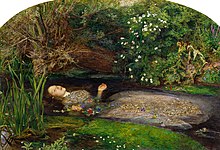 |
| Philip Webb in 1873 |
When Philip Webb was eleven years old his father, a physician, passed away. Consequently Webb had little choice but to abandon his aspirations to become a fine artist and pursue a career as an architect . In 1854, Webb was hired as chief assistant at a firm in Oxford, this was also the place where he met his life-long friend and client of the Red House, William Morris.
 |
| Red Barns House |
 |
| Ophelia by John Everett Milliais |
In 1858, Webb took on his first design commission to envision a family home for his good friend, William Morris, who was about to get married. The Red House was to be the first residential building of Modern Gothic, and its layout concept, such as the idea of having individual passageways leading up to the rooms, was later developed into the core characteristic in typical architecture of the Arts and Crafts movement.
In 1877, Webb became actively involved in the preservation work of old churches, thus becoming a key figure in the history of building conservation. The architect had gradually stopped working by the year of 1899 and enjoyed a peaceful retirement in Crawley, Sussex. Today, many examples of Webb's furniture design is owned and preserved by the National Trust.
Morris' friend and co-worker at his firm, Dante Gabriel Rossetti was a part of
------
Citation:
"Webb, Philip Speakman." Oxford DNB Article. Accessed December 11, 2012. http://www.oxforddnb.com/
view/article/36801?docPos=1.
"Philip Speakman Webb by Charles Fairfax Murray." Pre Raphaelite Art (blog). Accessed December 11,
2012. http://preraphaelitepaintings.blogspot.ca/2009/09/
philip-speakman-webb-by-charles-fairfax.html.
"Red Barns House, Kirkleatham Road, Redcar, Redcar and Cleveland." Heritage Explorer. Accessed
December 11, 2012. http://www.heritage-explorer.co.uk/web/he/
searchdetail.aspx?id=7711&crit=bell.

I do not even know how I ended up here, but I thought this post was great. I don't know who you are but certainly you're going to a famous blogger if you aren't already ;) Cheers!fall protection system
ReplyDelete